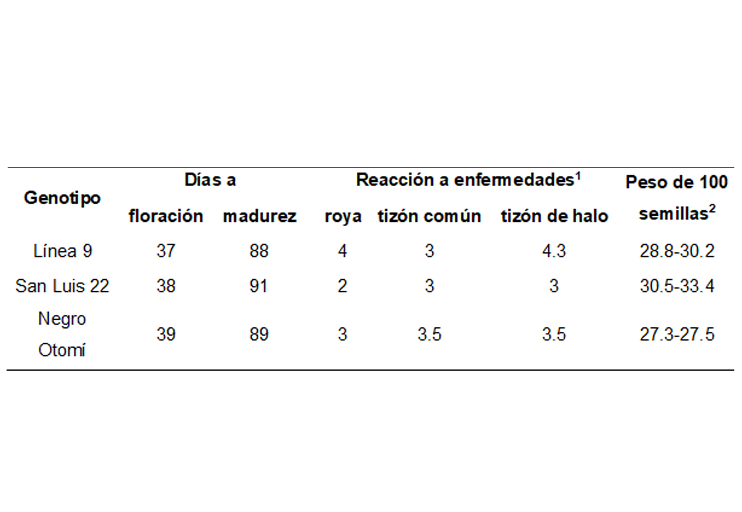‘San Luis 22’: a variety of shiny black rainfed beans for north-central Mexico
DOI:
https://doi.org/10.29312/remexca.v16i2.3411Keywords:
Phaseolus vulgaris L., BCMV, rendimiento, resistencia genéticaAbstract
‘San Luis 22’ is a medium-sized variety of shiny black beans, it has a prostrate type III indeterminate habit. It has an intermediate maturity cycle, with 95 to 100 days to physiological maturity. Its potential yield under rainfed conditions is 1 450 kg ha-1. In El Bajío, in field plantings, it is tolerant to common blight and resistant to rust, anthracnose, halo blight, and bean common mosaic. It has the following molecular markers: SW13, associated with the I gene of resistance to the bean common mosaic virus; Sk14, SI19 and SAD12, associated with the rust resistance genes Ur-3, Ur-5, and Ur-7; and SY20, SAS13, and SF10, associated with the anthracnose resistance genes Co-4, Co-42, and Co-10, respectively. ‘San Luis 22’ is recommended for rainfed conditions in El Bajío and the Altiplano of northern Guanajuato, Querétaro, San Luis Potosí, and Zacatecas. In El Bajío and northern Guanajuato, under rainfed conditions, ‘San Luis 22’ exceeded Negro Otomí by 191 kg ha-1, particularly in late sowing in August, which suggested greater phenological plasticity.
Downloads
References
Acosta-Gallegos, J. A.; Rosales-Serna, R.; Núñez-González, S.; Ochoa-Márquez, R.; Mendoza-Alvarado, S. and Singh, S. P. 2001. Registration of negro otomí shiny black bean. Crop Sci. 41(1):261-261. https://doi.org/10.2135/cropsci2001.411261x.
Anaya-López, J. L.; Garrido-Ramírez, E. R.; Chiquito-Almanza, E.; Tosquy-Valle, O. H.; Ibarra-Pérez, F. J. and López-Salinas, E. 2018. Identification of opaque black bean recombinant lines resistant to BCMV, BCMNV and BGYMV using molecular markers. Revista Mexicana de Ciencias Agrícolas. 9(3):601-614. https://doi.org/10.29312/remexca.v9i3.1219.
Anaya-López, J. L.; Ibarra-Pérez, F. J.; Rodríguez-Cota, F. G.; Ortega-Murrieta, P. F.; Chiquito-Almanza, E. y Acosta-Gallegos, J. A. 2021. Leguminosas de grano en México: variedades mejoradas de frijol y garbanzo desarrolladas por el INIFAP. Revista Mexicana de Ciencias Agrícolas. 12(25):63-75. https://doi.org/10.29312/remexca.v12i25.2827.
BIC. 2010. Bean Improvement Cooperative. SCAR markers linked with disease resistance traits in common bean (Phaseolus vulgaris) 1-19 pp. http://arsftfbean.uprm.edu/bic/wp-content/uploads/2018/04/SCAR-Markers-2010.pdf.
Fehr, W. R. 1987. Principles of cultivar development. Theory and techniques. Volume 1. Macmillan publishing company. New York. 319-331 pp.
FIRA. 2022. Fideicomisos Instituidos en Relación con la Agricultura. Panorama Agroalimentario Frijol 2022. Dirección de Investigación y Evaluación Económica y Sectorial. Ciudad de México, México. https://www.fira.gob.mx/InfEspDtoXML/abrirArchivo.jsp?abreArc=99218.
Miklas, P. N.; Kelly, J. D.; Beebe, S. E. and Blair, M. W. 2006. Common bean breeding for resistance against biotic and abiotic stresses: from classical to MAS breeding. Euphytica. 147(1):105-131. https://doi.org/10.1007/s10681-006-4600-5.
Osorno, J. M.; Vander-Wal, A. J.; Posch, J.; Simons, K.; Grafton. K. F.; Pasche. J. S.; Valentini. G. and Pastor-Corrales, M. 2021. A new black bean with resistance to bean rust: registration of ‘ND Twilight’. J. Plant Regist. 15(1):28-36. https://doi.org/10.1002/plr2.20094.
SNICS. 2017. Servicio Nacional de Inspección y Certificación de semillas. Guía técnica para la descripción varietal de frijol (Phaseolus vulgaris L.). 2ª Ed. https://www.gob.mx/cms/uploads/attachment/file/281559/Frijol-guia-Web-.pdf. 5-35 pp.
van Schoonhoven, A. and Pastor-Corrales, M. A. 1987. Sistema estándar para la evaluación de germoplasma de frijol. CIAT. Cali, Colombia. 56 p.
White, J. and Laing, D. R. 1989. Photoperiod response of flowering in diverse genotypes of common bean (Phaseolus vulgaris). Field Crops Res. 22(2):113-128. https://doi.org/10.1016/0378-4290 (89)90062-2.

Published
How to Cite
Issue
Section
License
Copyright (c) 2025 Revista Mexicana de Ciencias Agrícolas

This work is licensed under a Creative Commons Attribution-NonCommercial 4.0 International License.
The authors who publish in Revista Mexicana de Ciencias Agrícolas accept the following conditions:
In accordance with copyright laws, Revista Mexicana de Ciencias Agrícolas recognizes and respects the authors’ moral right and ownership of property rights which will be transferred to the journal for dissemination in open access. Invariably, all the authors have to sign a letter of transfer of property rights and of originality of the article to Instituto Nacional de Investigaciones Forestales, Agrícolas y Pecuarias (INIFAP) [National Institute of Forestry, Agricultural and Livestock Research]. The author(s) must pay a fee for the reception of articles before proceeding to editorial review.
All the texts published by Revista Mexicana de Ciencias Agrícolas —with no exception— are distributed under a Creative Commons License Attribution-NonCommercial 4.0 International (CC BY-NC 4.0), which allows third parties to use the publication as long as the work’s authorship and its first publication in this journal are mentioned.
The author(s) can enter into independent and additional contractual agreements for the nonexclusive distribution of the version of the article published in Revista Mexicana de Ciencias Agrícolas (for example include it into an institutional repository or publish it in a book) as long as it is clearly and explicitly indicated that the work was published for the first time in Revista Mexicana de Ciencias Agrícolas.
For all the above, the authors shall send the Letter-transfer of Property Rights for the first publication duly filled in and signed by the author(s). This form must be sent as a PDF file to: revista_atm@yahoo.com.mx; cienciasagricola@inifap.gob.mx; remexca2017@gmail.
This work is licensed under a Creative Commons Attribution-Noncommercial 4.0 International license.


